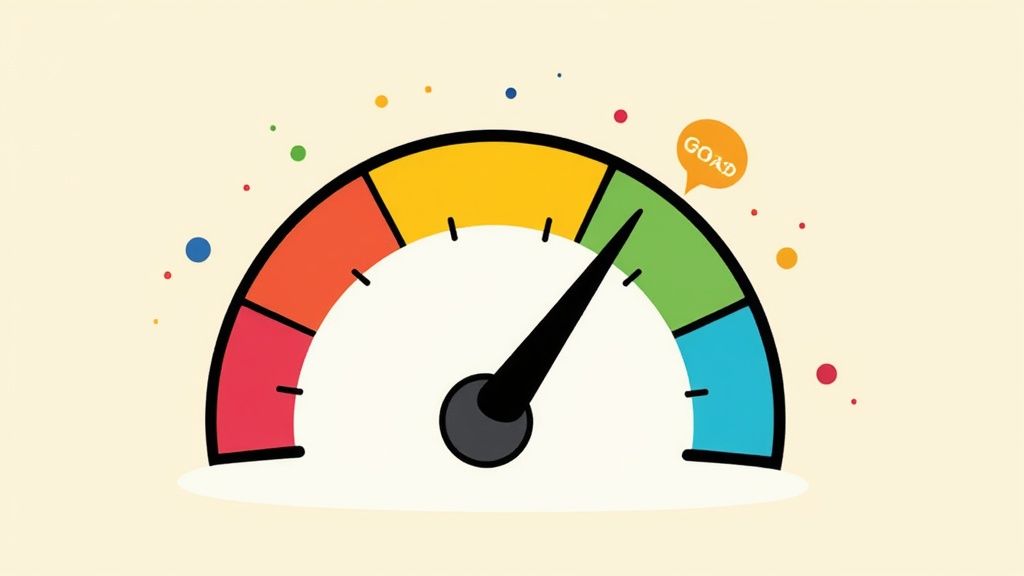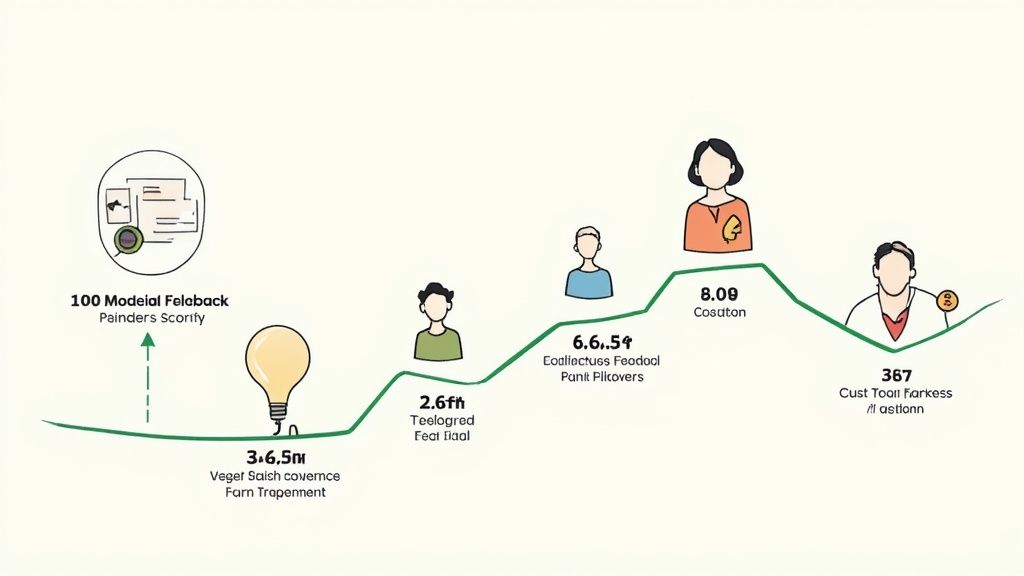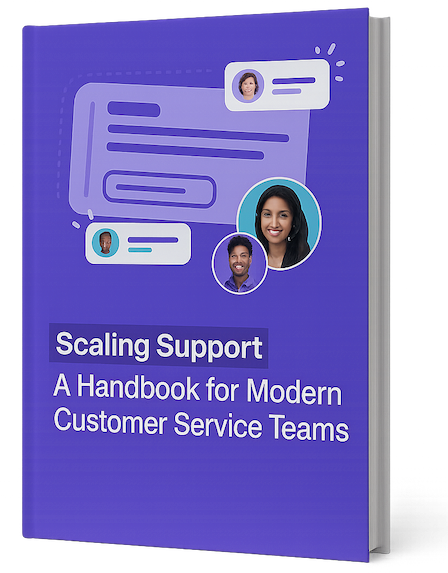Beyond Basic Metrics: Understanding Modern Customer Satisfaction

Simple satisfaction surveys don't tell the whole story anymore. Companies that rely only on basic feedback risk missing crucial insights about what their customers really think and feel. Modern approaches to measuring satisfaction dig deeper, exploring the reasons behind customer responses rather than just collecting surface-level ratings. For instance, understanding exactly why a customer had a bad experience is far more valuable than simply knowing they were unhappy.
The Evolution of Customer Satisfaction Scoring
Since the creation of the American Customer Satisfaction Index (ACSI) in 1994, measuring customer satisfaction has come a long way. Early methods focused mainly on basic survey data collection. Now, companies use more complete systems that look at multiple touchpoints throughout the customer journey. Better technology and analytics tools let businesses collect and analyze feedback in real-time, so they can respond to issues quickly and personalize their approach for each customer.
Common Mistakes in Customer Satisfaction Measurement
Many companies make key mistakes when measuring customer satisfaction, even though they know it's important. One common error is focusing too much on the overall satisfaction score without looking at what drives those numbers. A high overall score might hide serious problems in specific areas that need attention. Another mistake is collecting data inconsistently across different customer groups, which can lead to unclear or misleading results. Perhaps most importantly, gathering feedback without taking action makes the whole process pointless and wastes everyone's time.
Best Practices for Effective Customer Satisfaction Scoring
The most successful companies make feedback collection and action a regular part of their process. This starts with well-designed surveys that ask specific, relevant questions about each customer interaction. After talking with customer service, for example, you might ask "How well did our agent solve your problem?" Good satisfaction measurement also includes looking at online reviews, social media comments, and support conversation data to get a complete picture. Finally, collecting data is just the beginning – companies need to spot trends, fix problems quickly, and keep making improvements based on what they learn. Following these guidelines helps build a company culture that truly focuses on customers and encourages loyalty.
Building Your Customer Satisfaction Scoring Framework
Understanding and improving customer experience requires a structured approach. Moving beyond basic feedback collection towards a clear scoring framework provides actionable insights and data for informed decisions. The right framework helps identify trends, spot issues early, and make improvements that lead to more loyal customers.
Choosing the Right Metrics
Start with selecting the most relevant metrics to track customer satisfaction. While basic satisfaction scores provide an overview, using multiple complementary metrics paints a fuller picture. The Customer Effort Score helps measure interaction ease, while Net Promoter Score indicates loyalty levels. Each metric reveals different aspects of the customer experience, making it easier to identify specific areas needing attention.
Designing Effective Surveys
Once you've chosen your metrics, creating targeted surveys is essential for gathering meaningful data. Instead of broad questions, focus on specific touchpoints in the customer journey. For example, after a support interaction, ask "How satisfied were you with the agent's ability to resolve your issue?" rather than asking about general satisfaction. This focused approach helps pinpoint exactly what drives satisfaction at each stage.
Establishing Measurement Touchpoints
Customer satisfaction requires ongoing measurement throughout the customer lifecycle, not just one-time feedback. Set up regular check-ins after key moments like purchases, support contacts, and product updates to track satisfaction trends. Like regular health checkups that catch issues early, consistent satisfaction monitoring reveals emerging patterns before they become major problems.
Creating Your Scoring System
Converting survey responses into clear scores requires a straightforward system. A 5-point scale from very dissatisfied to very satisfied provides an easy way to track and compare feedback over time. Similar to academic grading, this numerical approach helps identify areas needing immediate focus. Consider giving extra weight to scores from critical touchpoints – for example, if product quality directly impacts retention, those satisfaction scores may carry more significance in your framework.
Aligning With Business Goals
Your satisfaction scoring framework should connect directly to key business objectives. If reducing customer churn is a priority, focus metrics and touchpoints on factors affecting retention. This targeted approach ensures that improvements in satisfaction scores translate to real business results. By linking customer feedback to specific goals, the framework becomes a practical tool for driving growth rather than just collecting data.
Does this rewritten version help? Let me know if you would like me to revise anything further. I aimed to make it flow more naturally while keeping the key points and insights from the original.
Turning Raw Data Into Actionable Intelligence

While customer satisfaction scoring provides essential data, the real value comes from translating those numbers into practical business decisions. Getting true insight requires looking beyond surface-level metrics to understand what's driving customer sentiment. This deeper analysis helps companies make meaningful improvements based on direct customer feedback.
Identifying Trends and Spotting Early Warning Signs
Smart data analysis helps catch potential issues before they become serious problems. Rather than only looking at overall satisfaction numbers, breaking down scores by customer segments, products, or touchpoints reveals specific areas needing attention. For instance, if new customers consistently report lower satisfaction, it may signal onboarding challenges that need fixing. Regular trend monitoring also shows how specific changes impact satisfaction – like whether a recent product update or service change affected scores positively or negatively. This granular view enables targeted improvements.
Determining High-Impact Improvements
Some changes matter more than others when it comes to customer satisfaction. By analyzing which aspects of the experience most strongly influence overall scores, companies can focus their efforts where they'll make the biggest difference. For example, data might show that support wait times have an outsized effect on satisfaction compared to other factors. Armed with this insight, reducing wait times becomes a clear priority for improving the overall customer experience. This focused approach helps teams use resources efficiently.
Communicating Findings and Building Buy-In
Getting stakeholder support requires presenting data in compelling ways that connect customer satisfaction to business results. Clear visuals like charts and graphs make trends and patterns easy to grasp. For example, showing how higher satisfaction scores correlate with increased customer lifetime value demonstrates the financial benefits of customer experience investments. These concrete connections help build support for customer-focused initiatives.
Practical Frameworks for Action
Several proven frameworks can guide analysis of customer satisfaction data. The "What-So What-Now What" approach provides a simple but effective structure:
- What? – Identify key findings in the data (e.g., satisfaction dropping among a specific group)
- So What? – Assess the business impact (e.g., risk of increased customer churn)
- Now What? – Define specific action steps (e.g., create targeted retention program)
Another useful tool is customer journey mapping, which tracks satisfaction across all customer touchpoints to pinpoint problem areas. The American Customer Satisfaction Index shows how tracking satisfaction over time provides insights into both business performance and broader economic trends as experienced by consumers. Using frameworks like these helps teams move systematically from data to action, leading to real improvements in customer satisfaction and loyalty.
Industry Benchmarks That Actually Matter
Getting the most value from customer satisfaction scoring means knowing which benchmarks really matter for your business. While collecting scores is important, the real insight comes from analyzing what those numbers mean specifically for your market and industry. Let's explore how to make your satisfaction metrics truly meaningful.
Setting Realistic Targets for Customer Satisfaction Scoring
When setting customer satisfaction goals, realism is key. While everyone wants perfect scores, research shows this rarely happens in practice. The American Customer Satisfaction Index (ACSI) consistently shows that satisfaction rates vary greatly between industries. For instance, SaaS companies typically see around 78% satisfaction, while e-commerce often scores higher. This means you'll get better insights by comparing yourself to similar businesses rather than companies in completely different sectors. Focus first on meeting or slightly exceeding your industry's average before pushing for more ambitious targets.
Identifying Meaningful Comparison Points
Finding the right benchmarks helps you gauge your true performance. Direct competitors make much better comparison points than companies in unrelated fields. Take a regional grocery chain – comparing their satisfaction scores to national mega-retailers won't tell them much. Instead, they should look at other regional grocers of similar size. Just as important is tracking your own progress over time. Even small improvements matter when they show steady gains month after month. This internal benchmarking reveals whether your customer service efforts are moving in the right direction.
Understanding the Drivers of Satisfaction in Your Market
Customer satisfaction works differently across industries because customers value different things. In luxury retail, personalized service might delight customers, while budget airline passengers care most about on-time flights and efficient baggage handling. By studying customer feedback through surveys, reviews and support interactions, you can identify what truly drives satisfaction in your specific market. This targeted insight helps you focus resources on improvements that will have the biggest impact.
Learning From High-Performing Organizations
Studying industry leaders can teach valuable lessons about improving satisfaction scores. Top performers often succeed through deep customer understanding and consistently exceeding expectations. They frequently invest heavily in employee training, recognizing that frontline staff directly impact customer happiness. You can adapt their best practices to your business, whether that means new feedback systems, updated processes, or better support tools. The key is continuously learning and adjusting your approach based on what works best for customer satisfaction in your market.
Implementing Your Scoring System: From Theory to Practice
Creating an effective customer satisfaction scoring system requires careful planning and execution. While sending surveys is important, success depends on taking a complete approach – from gathering data and analyzing results to training teams and making ongoing improvements.
Rolling Out Your Customer Satisfaction Scoring System
Start by setting clear goals for what you want to measure. Are you focused on post-purchase satisfaction, support interactions, or overall product experience? Having specific objectives helps guide implementation decisions.
Next, pick your scoring method. A simple 5-point scale works well in many cases, but consider if a thumbs up/down system or 10-point scale better fits your needs. Whatever approach you choose, use it consistently across all customer touchpoints.
Before full deployment, run a pilot test with a small group. This helps identify potential issues in data collection and analysis that you can fix before rolling out to all customers. The pilot provides real feedback to refine the process.
Training Your Team for Success
Your team plays a key role in gathering and using customer feedback effectively. Provide thorough training on the scoring system, explaining how it works and how the data guides improvements. For example, show support agents how their interactions directly affect satisfaction scores and business results.
Give your team authority to act on feedback. This could mean fixing individual customer issues quickly or identifying broader trends that need bigger changes. If customers often mention long wait times, empower the team to improve processes or adjust staffing.
Maintaining Consistency and Data Integrity
Getting reliable insights requires collecting and analyzing data consistently. Create clear rules for when and how to conduct surveys across different customer segments and interactions. Like in research, using consistent methods leads to dependable results.
Check your scoring process regularly to catch any deviation from protocols or new data collection challenges. These reviews help maintain data quality and let you adapt the system as needed, similar to calibrating research equipment.
Overcoming Common Implementation Challenges
New systems inevitably face obstacles like staff resistance, data issues, and limited resources. Address these proactively – for instance, reduce staff resistance by clearly communicating the system's value and offering incentives.
Work around resource constraints by focusing on key priorities and using affordable tools effectively. Free survey platforms and integrating feedback into existing communications can help gather data without major investment.
By tackling implementation challenges head-on and constantly improving based on results, your scoring system becomes a powerful tool for ongoing enhancement. Regular adaptation ensures the system stays relevant and effective as your business grows and customer needs evolve.
Future-Proofing Your Satisfaction Measurement

As customer needs evolve, your satisfaction measurement system needs to keep pace. Just like using an outdated map would lead you down inefficient routes, sticking with old measurement methods means missing crucial insights about what matters to customers today. The key is staying informed about new developments while thoughtfully incorporating tools that enhance your ability to understand customer feedback.
Integrating Emerging Technologies
Smart companies are finding new ways to gather deeper customer insights using advanced tools. For instance, artificial intelligence analysis of customer reviews and social comments reveals hidden patterns in sentiment that simple ratings miss. This helps companies understand not just what customers think, but why they feel that way. Modern feedback systems also let businesses collect responses right after interactions happen, so they can quickly adjust their approach based on what works best.
Maintaining Accuracy as You Grow
Getting accurate feedback becomes more complex as your customer base expands. Think of trying to count grains of sand – what works for a handful becomes impossible with a whole beach. Similarly, manual analysis of customer feedback that worked fine for a small business quickly becomes overwhelming at scale. That's why growing companies need good data tools and reporting dashboards to process all that feedback efficiently while still pulling out meaningful insights about how customers really feel.
Adapting to Evolving Customer Expectations
What makes customers happy keeps changing based on new technology, competitor offerings, and shifting preferences. Yesterday's "wow" factor often becomes today's basic expectation. The only way to keep your satisfaction measurement relevant is regular updates to your survey questions and scoring approach. Just as fashion trends move on, customer service standards advance too. By periodically reviewing what and how you measure, you can be sure you're tracking what actually matters to customers now.
Avoiding Common Pitfalls
Several mistakes can limit how useful your satisfaction scoring becomes. One major error is gathering feedback but never acting on it – like getting a diagnosis but skipping treatment. Another is focusing too much on overall scores while missing problems in specific areas. Teams also struggle when insights don't get shared effectively across the organization. By watching for and addressing these common issues, you can ensure your satisfaction measurement truly helps improve the customer experience.
Enhance your customer support operations, boost team morale, and elevate your customer satisfaction with SupportMan. Integrate Intercom ratings directly into Slack for real-time feedback and streamlined communication. Try SupportMan's free trial today—no credit card required! https://supportman.io


